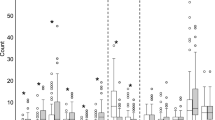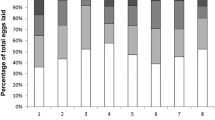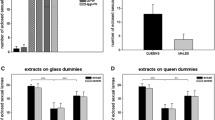Abstract
Since workers of the ant Aphaenogaster senilis can lay male eggs, reproductive conflict may occur between these workers. We examined the occurrence of worker conflicts in groups of workers either with or without the queen. Intranidal aggression was observed in each nest for 10 min each day, and the immatures produced were counted once a week for two months. Pairs of workers involved in aggression were taken regularly from each nest and used for chemical, morphological and anatomical analyses. The attacker and the attacked workers differed in their cuticular hydrocarbon profiles. The attacker and the attacked ants were at the same middle-aged fertile stage. The attacker ant was significantly larger and more fertile than the attacked ant, and more mature physiologically (poison gland was darker). There was apparently no stable hierarchy between laying workers. In the first weeks under queenless conditions, most eggs and larvae were destroyed, but they were later reared to obtain males. The intranidal worker aggression in this highly evolved ant is discussed in relation to dominance and worker policing.


Similar content being viewed by others
References
Boomsma JJ, Franks NR (2006) Social insects: from selfish genes to self organisation and beyond. Trends Ecol Evol 21:303–308
Boulay R, Lenoir A (2001) Social isolation of mature workers affects nestmate recognition in the ant Camponotus fellah. Behav Proc 55:67–73
Boulay R, Hefetz A, Cerdá X, Devers S, Francke W, Twele R, Lenoir A (2007) Production of sexuals in a fission-performing ant: dual effects of queen pheromone and colony size. Behav Ecol Sociobiol 61:1531–1541
Bourke AFG, Franks NR (1995) Social evolution in ants. Princeton University Press, Princeton, p 529
Clémencet J, Rome Q, Fédérici P, Doums C (2007) Aggressions and size-related fecundity of queenless workers in the ant Cataglyphis cursor. Naturwissenschaften 95:133–139
Crozier RH, Pamilo P (1996) Evolution of social insect colonies. Oxford University Press, Oxford, p 306
D’Ettorre P, Heinze J, Schulz C, Francke W, Ayasse M (2004) Does she smell like a queen? Chemoreception of cuticular hydrocarbon signal in the ant Pachycondyla inversa. J Exp Biol 207:1085–1091
Endler A (2004) Surface hydrocarbons of queen eggs regulate worker reproduction in a social insect. Proc Natl Acad Sci USA 100:10341–10346
Endler A, Hölldobler B, Liebig J (2007) Lack of physical policing and fertility cues in egg-laying workers of the ant Camponotus floridanus. Anim Behav 74:1171–1180
Hefetz A (2007) The evolution of hydrocarbon pheromone parsimony in ants (Hymenoptera: Formicidae)— interplay of colony odor uniformity and odor idiosynchrasy. Myrmecol News 10:59–68
Hölldobler B, Carlin NF (1989) Colony founding, queen control and worker reproduction in the ant Aphaenogaster (=Novomessor) cockerelli (Hymenoptera: Formicidae). Psyche 96:131–151
Hölldobler B, Wilson EO (1990) The ants. The Belknap Press, Cambridge, p 782
Howard RW, Blomquist GJ (2005) Ecological, behavioral, and biochemical aspects of insect hydrocarbons. Ann Rev Entomol 50:371–393
Ichinose K, Cerdá X, Christides J-P, Lenoir A (2005) Detecting nestmate recognition patterns in the fission-performing ant Aphaenogaster senilis: a comparison of different indices. J Insect Behav 18:633–650
Iwanishi S, Hasegawa E, Ohkawara K (2003) Worker oviposition and policing behaviour in the myrmicine ant Aphaenogaster smythiesi japonica Forel. Anim Behav 65:1–7
Kikuta N, Tsuji K (1999) Queen and worker policing in the monogynous and monandrous ant, Diacamma sp. Behav Ecol Sociobiol 46:180–189
Ledoux A (1971) Un nouveau mode de bouturage de société chez la fourmi Aphaenogaster senilis Mayr. C R Acad Sci Paris 273D:83–85
Ledoux A (1973) A propos du bouturage de société chez la fourmi Aphaenogaster senilis Mayr. C R Acad Sci Paris 277D:2199–2200
Ledoux A (1976) Inhibition exercée sur l’apparition de nouvelles femelles ailées, par la femelle reine pondeuse chez Aphaenogaster senilis (Hyménoptère Formicoidea). C R Acad Sci Paris 283D:1197–1200
Ledoux A (1984) Sur la présence d’ouvrières à parthénogenèse thélytoque observée chez Aphaenogaster senilis (Mayr) (Hyménoptère Formicoidea). C R Acad Sci Paris Sér III Sci Vie 299:859–861
Lenoir A, Fresneau D, Errard C, Hefetz A (1999) The individuality and the colonial identity in ants: the emergence of the social representation concept. In: Detrain C, Deneubourg JL, Pasteels J (eds) Information processing in social insects. Birkhäuser, Basel, pp 219–237
Lenoir A, Cuisset D, Hefetz A (2001) Effects of social isolation on hydrocarbon pattern and nestmate recognition in the ant Aphaenogaster senilis (Hymenoptera: Formicidae). Insect Soc 48:101–109
Monnin T (2006) Chemical recognition of reproductive status in social insects. Ann Zool Fennici 43:515–530
Monnin T, Ratnieks LWF, Jones GR, Beard R (2002) Pretender punishment induced by chemical signalling in a queenless ant. Nature 419:61–64
Nowbahari E, Fénéron R, Malherbe MC (1999) Effect of body size on aggression in the ant, Cataglyphis niger (Hymenoptera; Formicidae). Aggress Behav 25:369–379
Provost E, Rivière G, Roux M, Morgan ED, Bagnères A-G (1993) Change in the chemical signature of the ant Leptothorax lichtensteini Bondroit with time. Insect Biochem Mol Biol 23:945–957
Ratnieks LWF, Foster KR, Wenseleers T (2006) Conflict resolution in insect societies. Annu Rev Entomol 51:581–608
Smeeton L (1982) The effect of age on the production of reproductive eggs by workers of Myrmica rubra L. (Hym., Formicidae). Insect Soc 29:465–474
van Wilgenburg E, van Lieshout E, Elgar MA (2005) Conflict resolution strategies in meat ants (Iridomyrmex purpureus): ritualised displays versus lethal fighting. Behaviour 142:701–716
Acknowledgments
This study was performed during Ichinose’s stay in France with a fellowship from the French Government. We thank Xim Cerdá for ant collection. The authorities of the National Reserve of Doñana gave the authorization to collect the ants. Jean-Philippe Christidès provided us with precious suggestions for gas chromatography analyses. Julien Renault, Arnold Fertin and Guiléric Fraquet helped during the experiments. We thank Thibaud Monnin, Raphaël Boulay and four anonymous reviewers for very helpful comments on the manuscript. Hannah Reynolds revised the English.
Author information
Authors and Affiliations
Corresponding author
Electronic supplementary material
Below is the link to the electronic supplementary material.
10164_2008_145_MOESM1_ESM.jpg
Ovaries of A. senilis workers; top: a laying worker with ovocytes; bottom: an old worker with atrophied ovaries and traces of yellow bodies coloured in red (JPG 1554 kb)
10164_2008_145_MOESM5_ESM.doc
Means (± SD) of the quantity and proportion of cuticular hydrocarbons in the pairs of attackers and attacked workers (n=24). The quantity and proportion were square-root and arcsine-transformed, respectively, and compared by a paired t-test (df = 23 in all tests). Peak numbers are from Lenoir et al. (2001). Significant differences are shown in bold (DOC 39 kb)
About this article
Cite this article
Ichinose, K., Lenoir, A. Reproductive conflict between laying workers in the ant Aphaenogaster senilis . J Ethol 27, 475–481 (2009). https://doi.org/10.1007/s10164-008-0145-5
Received:
Accepted:
Published:
Issue Date:
DOI: https://doi.org/10.1007/s10164-008-0145-5




